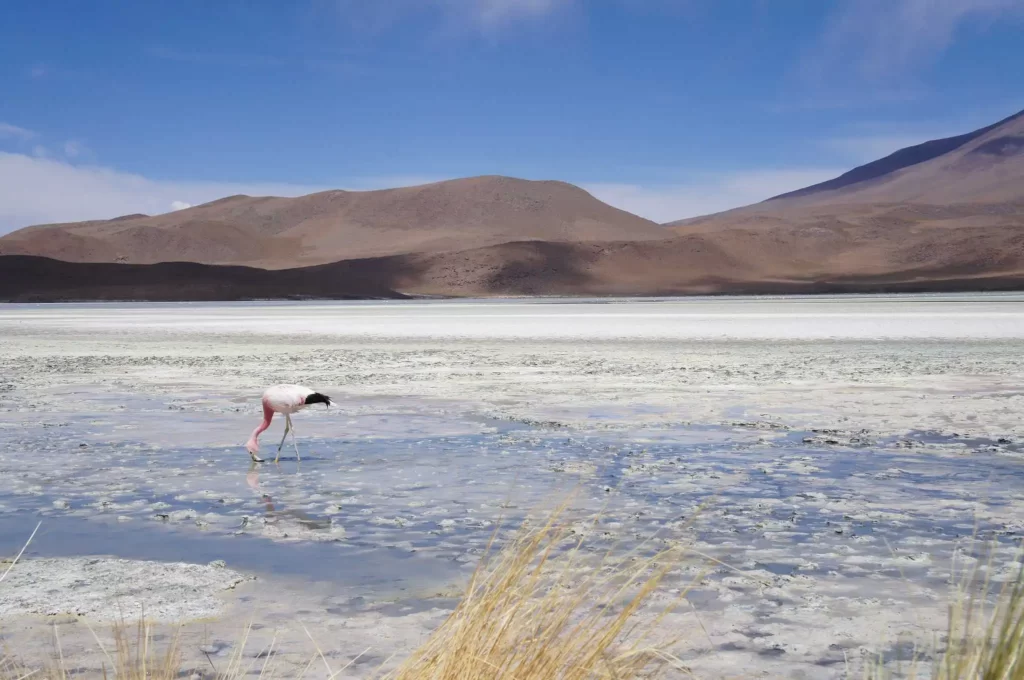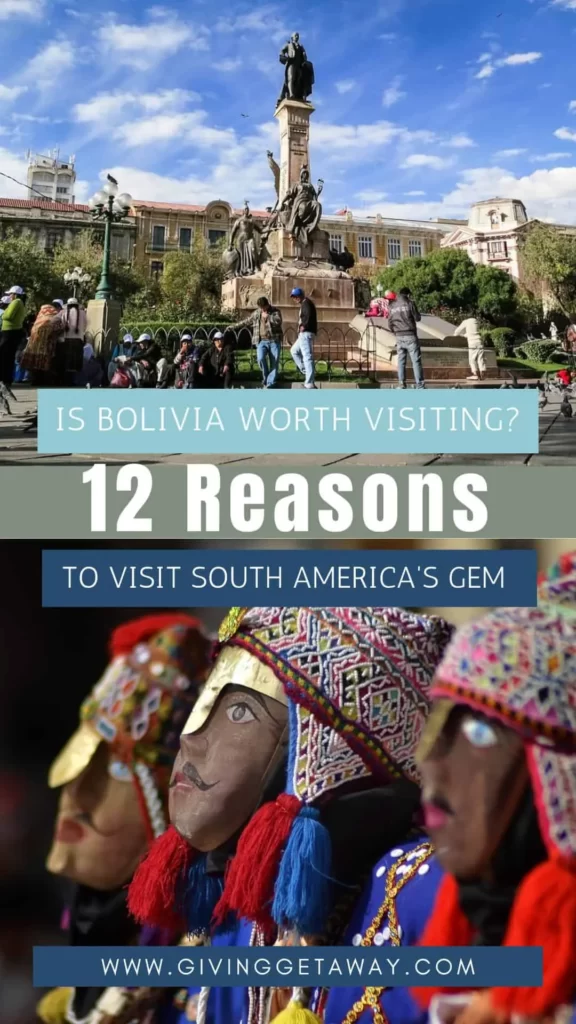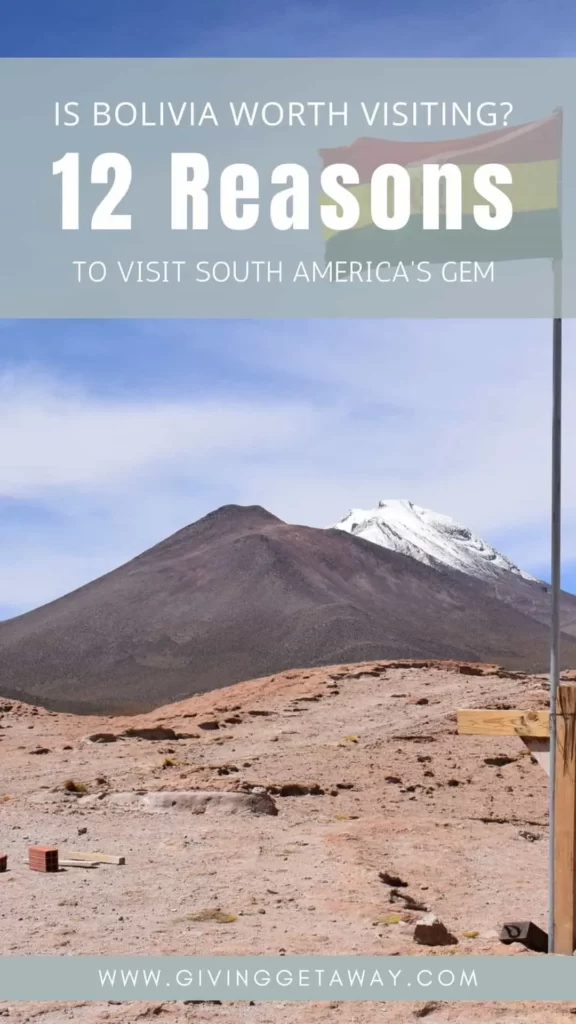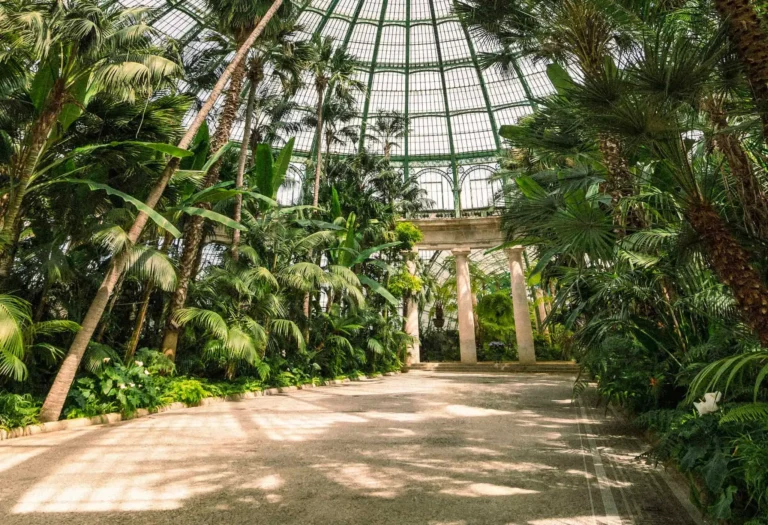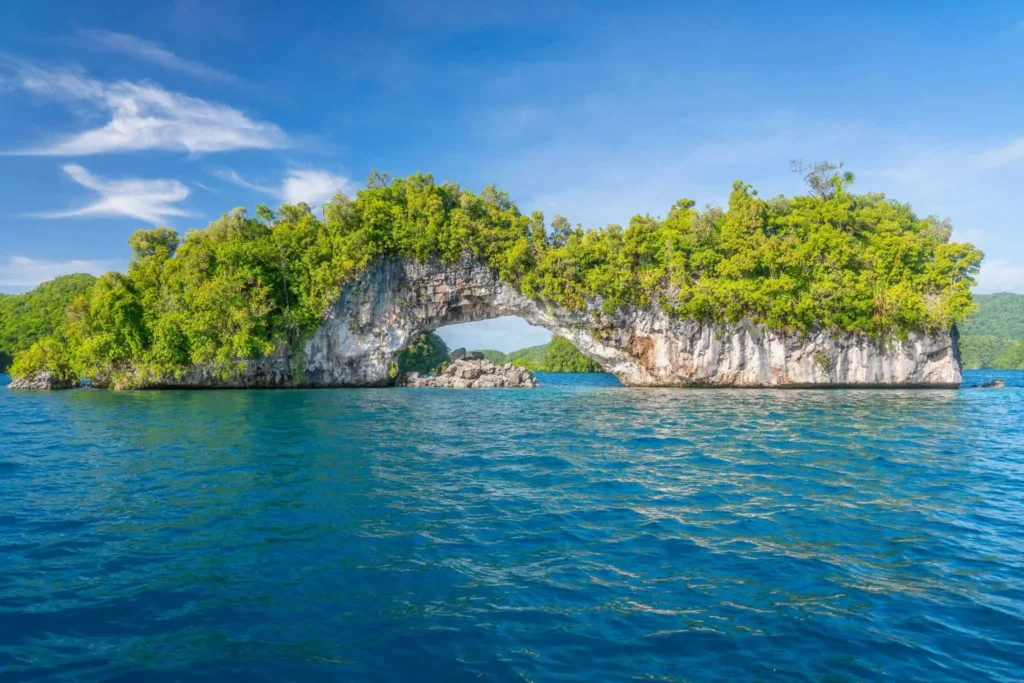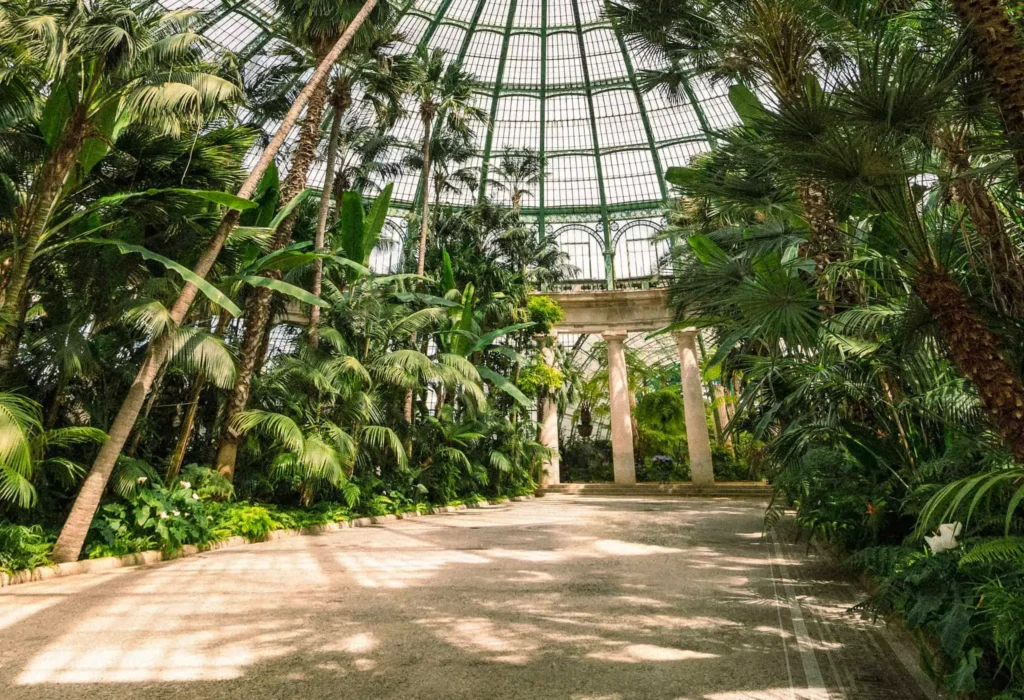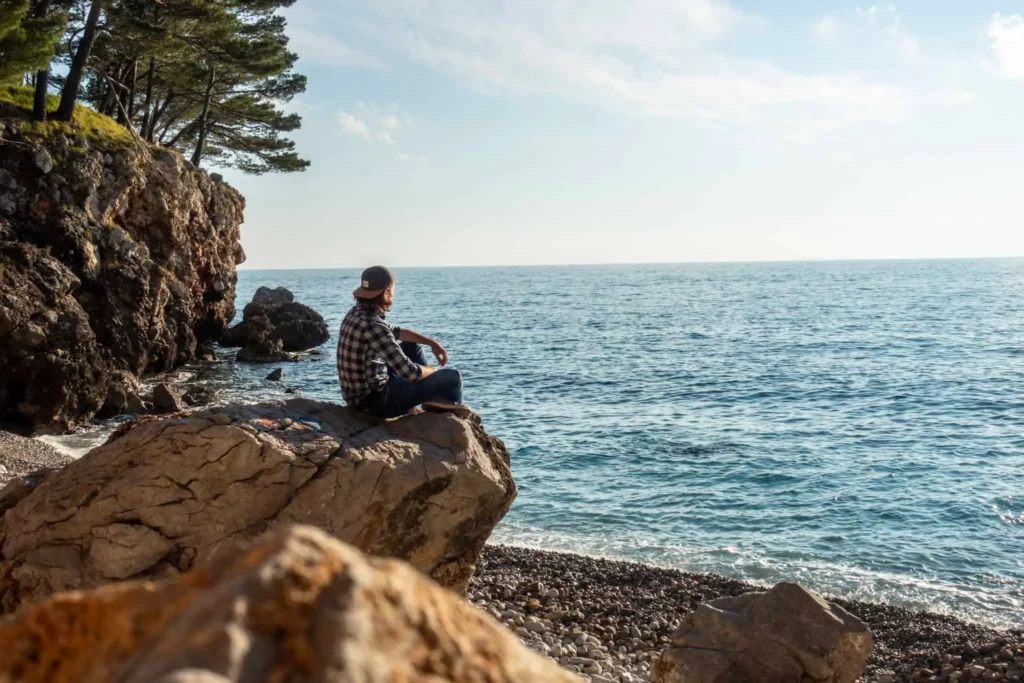| This post may contain affiliate links. Whenever you book or buy something through one of these, Giving Getaway gets a small commission, of which 100% will be donated to charity, without any extra cost to you! |
Are you thinking about visiting Bolivia, and wondering if it’s really worth it? Well, let me tell you, Bolivia is an incredible place that’s definitely worth your time and attention. During my time exploring this South American gem, I discovered a wide range of experiences that make it an amazing travel destination.
Bolivia is a country of extremes, with stunning landscapes like the vast Salar de Uyuni and a rich tapestry of indigenous cultures that add unique flavors to your journey. It’s a place where you can explore ancient ruins, vibrant cities, and the lush Amazon rainforest, all in one trip.
Before we dive into the details, let me tell you that you will come across some ads, affiliate links, and helpful tools on this page. Don’t hesitate to use them if they can make your travel planning easier. It won’t cost you extra, and 50% of the money I earn from these will go to charity.
And now, let’s find out why Bolivia is a must-visit destination and explore the 12 great reasons to put Bolivia on your travel radar!
Key Takeaways
- Bolivia boasts unique landscapes unlike any other in South America, including the world’s largest salt flat, Salar de Uyuni, and snow-capped peaks in the Andes mountain range.
- Bolivia is home to over 30 indigenous groups with distinct traditions and customs, and exploring indigenous culture supports and appreciates Bolivia’s diverse communities.
- Bolivia’s charming towns and cities, such as Sucre, La Paz, and Potosi, offer a chance to immerse in history and culture.
- Bolivia’s Amazon Rainforest is a haven for unique wildlife species and offers a glimpse into one of the world’s most diverse ecosystems.
1) Unique Landscapes
Bolivia boasts a multitude of unique landscapes that are unlike any other in South America. From the vast salt flats of Salar de Uyuni to the majestic peaks of the Andes, this country is a treasure trove for nature enthusiasts and adventure seekers alike.
One of the most iconic landscapes in Bolivia is Salar de Uyuni, the world’s largest salt flat. Spanning over 4,000 square miles (10,400 km²), this otherworldly expanse of white salt crusts creates a surreal and mesmerizing sight. Here you can wander across the seemingly endless flat surface, take perspective-bending photographs, and even stay in a hotel made entirely of salt.
For those seeking towering peaks and breathtaking vistas, Bolivia’s portion of the Andes mountain range does not disappoint. The snow-capped peaks of Huayna Potosi and Illimani provide a challenging yet rewarding experience for mountaineers. Lake Titicaca, the highest navigable lake in the world, offers tranquil beauty and the opportunity to visit the unique floating islands of the Uros people.
In addition to these natural wonders, Bolivia is home to the Yungas Road, famously known as the “Death Road.” This treacherous mountain pass attracts thrill-seekers from around the world who choose to bike down its narrow and winding path, surrounded by cliff edges and stunning mountain scenery.
2) Rich Indigenous Culture
Bolivia is home to over 30 indigenous groups, each with its own distinct traditions, languages, and customs. From the Aymara people in the highlands to the Quechua communities in the valleys, the indigenous culture is deeply rooted in the country’s history and continues to thrive today.
One of the most remarkable aspects of Bolivia’s indigenous culture is the preservation of ancient traditions. Witness traditional rituals, ceremonies, and festivals that have been passed down through generations. The vibrant colors, intricate textiles, and elaborate dance performances showcase the rich cultural heritage of the indigenous communities.
The indigenous culture also plays a significant role in daily life in Bolivia. Markets are bustling with activity, where locals sell their handmade crafts and produce. Traditional agricultural practices, such as terraced farming and herding llamas, are still practiced in many rural communities.
Moreover, Bolivia’s indigenous culture has influenced its cuisine, music, and art. Traditional dishes like salteñas and api showcase the unique flavors and ingredients of the Andean region. Indigenous music, with its haunting melodies and rhythms, can be heard in festivals and celebrations. And traditional art forms, such as pottery and weaving, are a testament to the indigenous people’s creativity and craftsmanship.
3) Charming Towns and Cities
With their picturesque architecture and vibrant atmosphere, the towns and cities of Bolivia offer a captivating blend of history and modern charm. From the colonial streets of Sucre to the bustling markets of La Paz, Bolivia’s urban centers are a testament to the country’s rich cultural heritage.
One of the most charming towns in Bolivia is Sucre, the constitutional capital and the birthplace of the country’s independence. Its cobblestone streets and well-preserved colonial architecture transport visitors back in time. The city is home to numerous museums and historic buildings, such as the Casa de la Libertad, where Bolivia’s independence was declared.
La Paz, on the other hand, is a bustling metropolis nestled in the Andes Mountains. Its unique geography, with buildings perched on steep hillsides, creates a visually stunning backdrop. The city’s markets, such as the famous Witches’ Market, are a treasure trove of local handicrafts and traditional medicinal herbs.
Another must-visit city is Potosi, once one of the wealthiest cities in the world due to its silver mines. Today, its historic center, with its grand colonial buildings and narrow streets, is a UNESCO World Heritage site.
4) Affordable Travel
If you are a budget-conscious traveler, exploring Bolivia offers an opportunity to experience South America’s gem without breaking the bank. This stunning country is known for its affordability, making it an ideal destination for those looking to make the most of their travel budget. From accommodation to food and transportation, Bolivia offers a wide range of affordable options that allow visitors to experience the country’s rich culture, breathtaking landscapes, and vibrant cities without breaking the bank.
When it comes to accommodation, Bolivia offers a variety of budget-friendly options. From cozy guesthouses and hostels to affordable hotels, there are plenty of choices that cater to different budgets. You can find comfortable and clean accommodations at affordable prices, allowing you to save money without compromising on comfort.
Food in Bolivia is not only delicious but also affordable. You can enjoy a hearty meal at local markets, street food stalls, and small restaurants, where the prices are reasonable and the portions are generous.
Transportation in Bolivia is also budget-friendly. Buses and shared taxis are the primary means of transportation, offering affordable options to explore different cities and regions. You can hop on a local bus or share a taxi with fellow passengers, saving money while experiencing the local way of getting around.
In addition to the affordability of accommodation, food, and transportation, Bolivia also offers a wide range of free or low-cost activities. From exploring the bustling markets and vibrant street art in La Paz to hiking through the stunning landscapes of the Uyuni Salt Flats, there are plenty of budget-friendly options for every type of traveler.
5) The Amazon Rainforest
Exploring the lush biodiversity and untamed wilderness, a journey into Bolivia’s Amazon Rainforest offers a captivating glimpse into one of the world’s most diverse ecosystems. Covering over 38,500 square miles (100,000 km²), this expansive rainforest is home to an incredible array of plant and animal species, making it a must-visit destination for nature enthusiasts and adventure seekers alike.
As you venture deep into the heart of the Amazon, you will be surrounded by towering canopies, vibrant foliage, and the symphony of sounds produced by countless creatures. The sheer diversity of life here is mind-boggling. From jaguars and giant river otters to macaws and capybaras, the Amazon Rainforest is a haven for wildlife enthusiasts seeking rare and elusive species.
In addition to its rich fauna, the Amazon Rainforest is a treasure trove of medicinal plants and traditional knowledge. Indigenous communities have called this place home for centuries, harnessing the power of the rainforest’s resources for healing purposes. Exploring their customs and learning about their sustainable practices provides a unique cultural experience that adds depth to your journey.
To fully experience the wonders of the Amazon, I recommend taking a guided tour or going on a river cruise. Knowledgeable guides will lead you through the forest, sharing their expertise and pointing out hidden gems along the way. Whether you choose to hike through the jungle, navigate the winding rivers, or sleep under a blanket of stars, the Amazon Rainforest promises an unforgettable adventure.
6) Cultural Festivals
Bolivia is a country that loves to celebrate, and its cultural festivals are a true testament to this spirit. These lively events offer a wonderful opportunity for you to immerse yourself in the heart of Bolivian traditions, where music, dance, and colorful parades take center stage.
Among the most famous festivals is the Oruro Carnival, an extravagant and dazzling spectacle that ranks among the largest and most significant in Bolivia. This carnival is a visual feast, with participants donning elaborate costumes, performing traditional dances, and parading through the streets with great enthusiasm. The vibrant atmosphere is infectious, and it’s an absolute must-see event for anyone looking to witness the creative exuberance of Bolivian culture.
What makes the Oruro Carnival even more special is that it invites you to be an active participant. The streets are filled with music, and you can join the dancers and musicians in the revelry. This unique aspect allows you to become part of the celebration, feeling the pulsating energy and genuine warmth of the Bolivian people.
In addition to the grand Oruro Carnival, Bolivia’s towns and cities host numerous smaller local celebrations throughout the year. These events offer a glimpse into the rich cultural tapestry of the country. You might stumble upon colorful parades, traditional music performances, and regional dances that are an integral part of Bolivia’s identity.
7) Unique Wildlife
What unique wildlife can be found in Bolivia’s Amazon Rainforest? The answer is a breathtaking array of species that are found nowhere else in the world. Bolivia’s Amazon Rainforest is a haven for biodiversity, offering a rich tapestry of flora and fauna that will leave any nature enthusiast in awe.
One of the most iconic creatures that call this rainforest home is the jaguar. With its striking coat and powerful build, the jaguar is the largest wildcat in the Americas. Spotting one of these elusive creatures in the dense jungle is a rare and unforgettable experience.
Another remarkable resident of Bolivia’s Amazon Rainforest is the pink river dolphin. These enchanting creatures, with their pink coloration, can be found swimming gracefully through the rivers and lakes of the region. They are highly intelligent and their presence adds a touch of magic to the already mystical rainforest.
The rainforest is also home to a variety of primates, including the titi monkey, spider monkey, and capuchin monkey. These playful and curious creatures can be seen swinging through the trees, showcasing their acrobatic abilities.
Other unique wildlife found in Bolivia’s Amazon Rainforest includes the giant river otter, the anaconda, the harpy eagle, and the three-toed sloth. Each of these creatures plays a vital role in the delicate ecosystem of the rainforest, creating a truly remarkable and interconnected web of life.
8) Adventure Sports
Bolivia offers thrilling opportunities for adventure sports enthusiasts. With its diverse landscapes and rugged terrains, this South American gem is a playground for adrenaline junkies. From soaring through the sky on a paragliding adventure to tackling the white-water rapids of its raging rivers, Bolivia has something to offer for every adventure seeker.
One of the most popular adventure sports in Bolivia is mountain biking. The country’s challenging mountain trails and stunning scenery make it a haven for mountain biking enthusiasts. Whether you’re a beginner or an experienced rider, Bolivia’s diverse terrain offers a range of trails to suit all skill levels. From the famous Death Road, a thrilling descent through the Andes, to the remote trails of the Salar de Uyuni, there’s no shortage of exhilarating biking experiences.
For those looking for a different kind of thrill, Bolivia also offers opportunities for rock climbing and trekking. The towering peaks of the Cordillera Real provide the perfect backdrop for challenging climbs, while the vast expanses of the Altiplano offer endless opportunities for exploration on foot.
If water sports are more your style, Bolivia has you covered as well. The country is home to some of the world’s most breathtaking lakes, such as Lake Titicaca and Lake Poopó, where you can try your hand at kayaking or stand-up paddleboarding. Additionally, the rivers that flow through Bolivia’s rugged landscapes provide the perfect setting for white-water rafting and kayaking adventures.
9) Ancient Ruins
Continuing the exploration of Bolivia’s cultural riches, a journey through the ancient ruins of the country unveils a fascinating glimpse into its historical past. Bolivia is home to some of the most remarkable ancient ruins in South America, each with its own unique story and architectural marvels.
One of the most famous ancient ruins in Bolivia is Tiwanaku, a UNESCO World Heritage Site located near Lake Titicaca. This pre-Columbian city was once the center of a powerful empire and is renowned for its impressive stone structures, intricate carvings, and monumental gateways. Exploring the ruins of Tiwanaku allows you to delve into the rich history and culture of the ancient Tiwanaku civilization.
Another must-visit ancient site is the ancient Inca city of Incallajta. Situated in the Cochabamba Department, Incallajta was once a thriving Inca settlement and is now a well-preserved archaeological site. The site offers stunning views of the surrounding valleys and mountains, and you can wander through the remains of temples, houses, and ceremonial plazas, gaining insight into the daily lives of the Incas.
The ancient ruins of Samaipata are also worth exploring. Located in eastern Bolivia, these ruins were once a ceremonial center for the pre-Inca people and later served as a fortress for the Inca Empire. The main attraction at Samaipata is the massive rock carving known as El Fuerte, which features intricate carvings and is believed to have had both religious and astronomical significance.
10) Unique Markets
When exploring Bolivia, you cannot overlook the unique markets that add to the country’s charm. Bolivia is renowned for its vibrant and authentic markets that offer a glimpse into the country’s rich culture and traditions. Whether you’re a food enthusiast, a lover of textiles, or simply enjoy immersing yourself in the hustle and bustle of local life, Bolivia’s markets have something for everyone.
One of the most famous markets in Bolivia is the Witches’ Market in La Paz. Here, you’ll find a fascinating array of herbs, potions, and traditional remedies used by the local Aymara people for centuries. It’s a truly unique experience, as you wander through narrow streets lined with colorful stalls, surrounded by a sea of intriguing items.
Another must-visit market is the Mercado Rodriguez in Cochabamba. This lively market is a treasure trove of fresh produce, spices, and handmade crafts. You can sample delicious local dishes like salteñas (meat-filled pastries) or purchase unique souvenirs like handwoven textiles and pottery.
If you’re in the Sucre region, don’t miss the Tarabuco Market. This traditional indigenous market showcases the craftsmanship of the local Quechua people. From intricately embroidered textiles to handmade jewelry, you’ll find beautiful and authentic pieces that reflect Bolivia’s rich cultural heritage.
11) Indigenous Handicrafts
The indigenous handicrafts in Bolivia showcase the rich artistic traditions and cultural heritage of the local communities. These handcrafted treasures are a true reflection of the country’s unique and diverse indigenous cultures, each with its own unique style and techniques.
From intricately woven textiles to beautifully crafted ceramics and woodwork, Bolivia’s indigenous artisans excel in preserving and passing down their ancestral skills from generation to generation. The vibrant colors, intricate patterns, and exquisite details found in these handicrafts are a testament to the creativity and craftsmanship of the Bolivian people.
One of the most famous handicrafts in Bolivia is the intricately woven textiles made by the Quechua and Aymara communities. These textiles often feature traditional motifs and symbols that hold deep cultural significance. The weavers use techniques passed down through centuries, using natural dyes and traditional backstrap looms to create stunning pieces of art.
Another notable form of indigenous handicraft in Bolivia is the ceramic pottery produced by the artisans of the Yungas region. They use traditional techniques to shape and decorate their pottery, incorporating unique designs inspired by nature and their surroundings. The result is a beautiful fusion of tradition and creativity.
In addition to textiles and pottery, Bolivia is also known for its exquisite woodwork. Artisans from regions like Copacabana and Tarija create intricate carvings and sculptures using sustainably sourced wood. These pieces often depict religious or mythical figures, showcasing the spiritual beliefs and traditions of the indigenous communities.
Visiting the markets and workshops where these handicrafts are made is a truly enriching experience. It allows you to witness the skill and dedication of the artisans firsthand and allows you to support their livelihoods. Whether you’re purchasing a handwoven textile, a beautifully painted ceramic, or an intricately carved wooden piece, each purchase supports the preservation of Bolivia’s indigenous artistic heritage.
12) Delicious Food
Indigenous handicrafts in Bolivia offer a captivating glimpse into the country’s vibrant cultural heritage, and the culinary delights found in this South American gem are equally as enticing. Bolivia’s cuisine is a fusion of indigenous traditions and Spanish influences, resulting in a unique and flavorful gastronomic experience.
One of the must-try dishes in Bolivia is salteñas. Similar to empanadas, these savory pastries are filled with a delicious mixture of meat, potatoes, peas, and spices. Their golden crust and juicy fillings make them a popular street food across the country. Another specialty is anticuchos, skewers of marinated beef heart cooked over an open flame. These tender and flavorful meat treats are often served with a side of potatoes or corn.
For seafood lovers, Bolivia’s Lake Titicaca offers a delectable treat called trucha, which is a grilled trout served with rice, potatoes, and a tangy salsa. The trout from the lake is known for its freshness and delicate flavor.
To satisfy your sweet tooth, try the traditional dessert called cuñape. These small, cheesy bread rolls are made from yuca flour and are often enjoyed with a cup of mate de coca, a tea made from coca leaves.
Frequently Asked Questions
What Is the Best Time of Year to Visit Bolivia?
The best time of year to visit Bolivia depends on the specific activities and regions you plan to explore. Generally, the dry season from May to October is popular among tourists as it offers clear skies and mild temperatures. However, if you wish to witness the stunning landscapes of the Uyuni Salt Flats, the rainy season from November to April is recommended.
Are There Any Safety Concerns for Tourists in Bolivia?
When considering the safety concerns for tourists in Bolivia, it is important to evaluate the current situation and gather reliable information. Bolivia, like any other country, has its share of safety concerns that tourists should be aware of. These may include petty theft, street crime, and potential political unrest. You should stay informed about the latest travel advisories, avoid displaying wealth, and take necessary precautions to ensure your safety while exploring this beautiful country.
What Is the Local Currency in Bolivia and Where Can I Exchange Money?
The local currency in Bolivia is the Bolivian boliviano (BOB). It is recommended to exchange money at official exchange offices or banks in major cities like La Paz or Santa Cruz. These institutions offer fair exchange rates and provide a safe and reliable service. It is important to have some cash on hand, as credit cards may not be accepted everywhere. Additionally, be cautious of counterfeit bills and ensure that you receive proper change when making purchases.
How Easy Is It to Navigate Around Bolivia as a Non-Spanish Speaker?
Navigating around Bolivia as a non-Spanish speaker can present some challenges. While English is spoken in tourist areas, outside of those, communication can be difficult. It is recommended to learn some basic Spanish phrases to make interactions easier. Additionally, having a guidebook or a translation app can help understand signs and directions.
Are There Any Specific Customs or Etiquette That You Should Be Aware of When Traveling in Bolivia?
When traveling in Bolivia, you need to be aware of the country’s customs and etiquette. This will help ensure a positive and respectful experience. Some key customs to note include greeting others with a handshake, showing respect for elders, and being mindful of personal space. It is also important to be aware of the local cultural practices, such as asking permission before taking photos and respecting sacred sites.
Conclusion
To sum it up, Bolivia is definitely worth a visit, and I hope these 12 reasons have convinced you. During my time in this country, I experienced the magic of its diverse landscapes, rich cultures, and unique adventures. Bolivia combines ancient traditions with modern vitality, making it a fantastic place for travelers.
As you plan your next trip, consider adding Bolivia to your list. Whether you’re interested in the surreal beauty of Salar de Uyuni, colorful local festivals, or the lush Amazon rainforest, Bolivia will provide you with unforgettable memories. And remember, Bolivia isn’t just a standalone destination; it’s a great starting point for exploring other incredible places in South America.
If you are now ready to book your trip to Bolivia, I encourage you to consider using Giving Getaway for your travel essentials such as hotels, flights, rental cars, and more.
By booking through Giving Getaway, you’ll not only have an amazing trip, but you’ll also make a difference. 50% of the commission earned from each completed booking goes towards organizing charity events, such as the 2021 Christmas gift drive for kids and teenagers in a children’s home in Montenegro. So, book your trip with Giving Getaway and make a positive impact while enjoying your travels!

